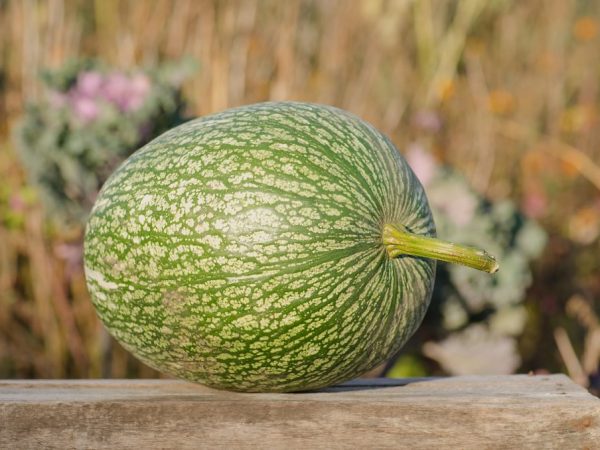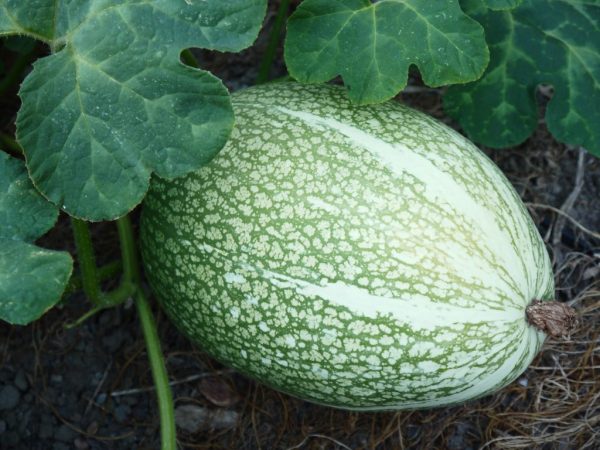Features of growing fig-leaved pumpkin
Fig-leaved pumpkin is one of the varieties of a crop very popular with gardeners. Its alternative name is fitcephaly. The homeland of the vegetable is considered to be South America, because it was from there that its seeds were brought to Europe.

Features of growing fig-leaved pumpkin
Species characteristic
Black-seed pumpkin is a perennial plant. It got its name - fig-leaved - because of the external resemblance of its leaves to a fig (fig) tree. The shoots of the plant can be up to 10 m in length. The flowers of the phycephaly are almost identical with the inflorescences of its "relative" - the common pumpkin.
The appearance of the fruit resembles watermelons: on a dark green background there are whitish oblong spots. The pulp itself is white, juicy, with a slight sweetish aftertaste.
Among the main characteristics of the fig-leaved pumpkin are the following:
- the vegetable is frost-resistant, tolerates temperature changes well;
- the pumpkin grows quickly and brings good yields;
- characterized by a long flowering period, but does not interbreed with other pumpkin varieties;
- flowers of orange or yellow tint;
- the culture is resistant to putrefactive diseases;
- pumpkin requires the presence of a sufficient volumetric space due to long stems and large curly leaves;
- fruits are medium-sized, have an oblong shape;
- weight varies from 2 to 5 kg, record-breaking pumpkins can grow up to 20 kg;
- the peel of the culture is rough and thin;
- the seeds of the vegetable are black.
Beneficial features
The vegetable is characterized not only by its high taste, but also by its beneficial properties.
The pulp contains a wide variety of vitamins, one of which is vitamin D, which has a beneficial effect on metabolism and strengthening bone tissue. It also contains carotene, which is good for vision.
The leaves of the plant contain useful trace elements such as sodium, iron, calcium, phosphorus, etc. Black pumpkin seeds are rich in B vitamins, which improve intestinal function and have a positive effect on skin condition.
Growing features
There are 2 ways to grow a vegetable: from seeds or seedlings.
In the first method, it is recommended to soak the seed in water at room temperature for several days. After germination, they are placed in prepared soil, which is fertilized with ash and humus.
To prevent the soil from drying out, as well as to increase the temperature in the holes, they are mulched. Already after 1.5-2 weeks, the first shoots will be visible.
To get an earlier harvest, it is recommended to grow the crop from seedlings, which they begin to prepare in 2-3 weeks in special pots or small containers. Seedlings need systematic moderate watering, daily ventilation, and maintaining an even temperature.
If in the territory of vegetable cultivation the summer does not please with its duration, it is recommended to pinch the lateral shoots, because they grow very strongly. This procedure will help speed up the ripening of the fruit.
Advantages and disadvantages

The fruits are versatile in use
Experienced gardeners note that the fitcephaly pumpkin has a number of advantages. These include:
- resistance to cold weather. Frosts are not a hindrance to fruit ripening;
- unpretentiousness. The vegetable does not require much effort to grow or care for;
- long shelf life. The culture perfectly “survives” until the next seasonal harvest, while preserving all its useful and taste qualities;
- wide range of applications. Fycephaly is widely used in cooking, and is also used as a folk remedy for the treatment and prevention of various diseases.
Having made the decision to plant a fig-leaved pumpkin in your garden, you should take into account several nuances. It will depend on them how generous the harvest of this vegetable will be.
Fitcephaly does not grow well in cold climates, where daylight hours are short and the air temperature drops significantly at night. It requires a wide enough space for its growth and development.
The disadvantage of this species is its rarity. Due to the fact that it has not yet become widespread, it is almost impossible to get seeds on the free market.
Experimental gardeners who are engaged in its cultivation are happy to share the seeds, as well as experience in growing this exotic vegetable.
Application
Fitcephaly is used not only to prepare a wide variety of dishes, but also as a remedy. This is due to the fact that the vegetable is becoming more common in Russia.
Jam is prepared from ripe pumpkin fruits, it can be stewed, fried, pickled, used as an ingredient for salads, etc.
Fig-leaved pumpkin is widely used as a remedy. It is used in the following cases:
- with diseases of the cardiovascular system;
- in case of problems with the pancreas;
- with renal failure;
- with diseases of the digestive tract;
- for the treatment of diseases of the gallbladder, liver;
- with skin diseases;
- with obesity, etc.
Gardeners reviews
Fig-leaved pumpkin does not require additional expenditure of time and care products, and in the fall it pleases with an abundant harvest of beautiful fruits. In appearance, these vegetables are similar to the juicy and beloved by many berries - watermelon.
The plant also performs a decorative function - beautiful curls in the form of vines, abundant flowering ennobles the territory, adds colors and greenery to the site.
Gardeners claim that, in addition to aesthetic pleasure, they get a lot of pleasure from the taste of the vegetable. This fruit is also noted for its beneficial properties that help in the fight against many diseases.
A pumpkin of this species has just begun to conquer the vastness of our country, but has already managed to establish itself exclusively on the positive side. Be sure to try planting this wonderful vegetable in your garden.

